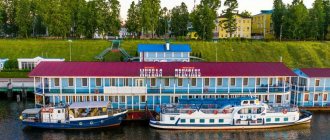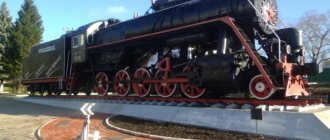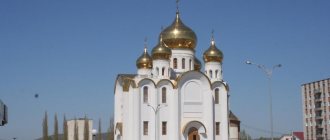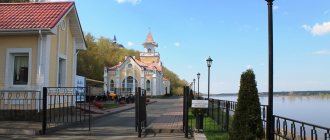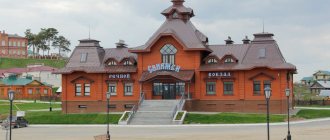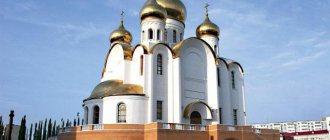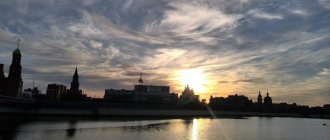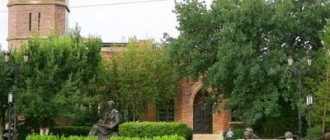The first mentions of Sterlitamak should be dated back to the middle of the 18th century. It was at this time that the government of the Russian Empire decided to begin the construction of postal stations, which in those days were called pits, along the road from Ufa to Orenburg. One of these was organized on the site of a Tatar village near the Sterli River. The merchant Savva Tetyushev did a lot for the development of this settlement. It was here that he proposed to build a salt pier. Thus, the town became not only one of the main settlements for the extraction and shipping of salt, but also an important communication center, which began to develop thanks to the commissioning of metallurgical plants in this region of Bashkiria.
Museum of History and Local Lore
Which attraction of Sterlitamak should tourists start their excursion with? The local history museum will tell you about the history of this region. It is located in a solid, beautiful, high-quality building. About a hundred years ago it belonged to one of the branches of the Siberian Merchant Bank. The two-story red building with large windows located almost close to each other, framed by white molding, looks simply fabulously beautiful. The museum contains several tens of thousands of rare exhibits.
Visitors are especially impressed by the geological exhibition. And this is not surprising, since the Ural land is a kind of jewelry box. Here you can find jasper, rock crystal, agate and many other types of semi-precious stones. The exhibition also includes the famous Sterlitamak meteorite. Also interesting are exhibitions dedicated to the culture, history and life of the local population, as well as the years of the Second World War.
Interesting facts about Sterlitamak
Fact 1. In the past, the city of Sterlitamak managed to be the capital of Bashkiria, although not for long - only 3 years. Like Nizhnevartovsk, it grew out of a river pier built to receive merchant ships. The founded pier was called Ashkadarskaya for a long time, but later the modern name Sterlitamak took shape, based on the name of the Sterli River and the word “tamak”, meaning “mouth” in the Bashkir language.
Fact 2. The area of Sterlitamak exceeds 108 km². It is almost twice the size of San Marino, the oldest republic in Europe, 4 times the size of the Pacific country of Tuvalu and 54 times the size of the Principality of Monaco. At the same time, about 280,000 people live here, which is several times the population of states such as Micronesia or Grenada. Interestingly, in Sterlitamak the population has been growing steadily since its founding, and there have been no serious declines in the local demographic situation.
Fact 3. This is one of the few cities in Russia that still has trolleybus transport, which pollutes the environment significantly less than bus transport. Moreover, Sterlitamak trolleybuses carry more than 100,000 passengers daily, which is more than 50% of the total local passenger traffic.
Fact 4. At the end of the 20th century, the environmental situation in Sterlitamak gradually began to become threatening, and local authorities began to work closely on improvement. Since the 90s, regular tree planting has been carried out here, and this has borne fruit - over the past few decades, Sterlitamak has twice taken first place (and three more times - second) in the competition “The most comfortable city in Russia with a population of 100 thousand to 1 million” Human".
Fact 5. This is a fairly multinational city, and Russians here account for about 50% of the townspeople. The remaining 50% is more or less evenly divided between representatives of the Chuvash, Bashkir and Tatar peoples.
Fact 6. Since the mid-20th century, Sterlitamak has become the “capital of motorcycle racing” in the USSR, and motorsports have gained enormous popularity here. After the collapse of the USSR, there was no money to finance athletes for a long time, but then the situation began to improve, and now Sterlitamak motorcycle racers constantly take part in the most prestigious competitions around the world.
Fact 7. During the uprising of Emelyan Pugachev, rebel troops passed through Sterlitamak for several years. The authorities, having received orders from the capital, tried to organize a militia to repel them, but while the militia was being formed, Pugachev’s agitators managed to convince the townspeople that they were the ones fighting for the real tsar. As a result, the militias went over to the side of the rebels.
Fact 8. One of the oldest Russian newspapers, Sterlitamaksky Rabochiy, is published here. It was born back in 1917, immediately after the revolution, and has been published without interruption since then.
Fact 9. Sterlitamak is connected to Ufa by railway, but very original transport rides on the rails here - a rail bus, a rail bus. There is simply no electricity on this section of the railway track, electric trains cannot run here, so it was decided to put buses on the rails as an alternative.
Fact 10. Industry here is well developed, but the lion's share of income here comes from the production of soda. According to this parameter, Sterlitamak ranks first in Russia, and soda accounts for about 25% of the total local trade turnover.
Tatian Church
An interesting landmark of the city is the Tatiana Church. Sterlitamak can be proud of this beautiful temple.
It is located in the courtyard of the Mother of God-Tabynsky convent. At the very end of the 19th century, the church was founded by Tatyana Dyakova. Under her, an almshouse named after the Fedorovs was also opened. Like many Orthodox churches of other denominations, the Tatian Church was closed in the thirties of the last century. However, in the forties it was returned to believers. Moreover, for its help in raising funds for the front, the shrine received gratitude in 1945 from the Commander-in-Chief.
This, however, did not prevent the communist authorities from closing the Orthodox church in 1959. This time a medical school was placed in the church building. Of course, the unique wall paintings were barbarously destroyed during the redevelopment of the building. After the collapse of the Soviet Union, the building, thoroughly mutilated, was returned to the Orthodox Church. Now you can visit the temple and admire the interior decoration and beautiful appearance of the light pink building with a three-stage spacious bell tower and shiny domes.
Entertainment and recreation with children in Sterlitamak
If the question arises about where to go with your child, Sterlitamak will offer several places that will be interesting for children to visit. There is not a lot of entertainment here, but there is some.
Sports complex "Sterlitamak-Arena"
- Address: Kommunisticheskaya st., 101.
Sterlitamak Arena is a modern sports complex built in 2012. A venue for competitions in various sports, concerts and other public events. Fans of active recreation can have a great time here: there is an ice skating rink, grounds for team sports games and a fitness room on site. There are several catering outlets, including children's ones.
Park of Culture and Leisure named after Yuri Gagarin
- Address: st. Furmanova, 15.
In honor of the first cosmonaut in the history of the planet, Sterlitamak was named a place suitable for both relaxation and active entertainment. In the Central Park of Culture and Culture you can stroll along the alleys, as well as ride on a variety of attractions of varying degrees of extremeness - both for very young children and toddlers, as well as for young people and the whole family.
Guests of any age category will be able to feel like “a little Gagarin” here. Young visitors will be attracted by the dinosaur figures installed in the park, and there are trampolines for those who want to jump. The park area also often hosts arcade games and prize slot machines.
Nur al-Iman Mosque
What attractions should tourists see (Sterlitamak)? About twelve years ago, the Nur al-Iman mosque was built in the city. Translated into Russian, the name means “ray of light.” The beautiful building, surrounded by rising green minarets, looks majestic. And if you climb to its upper platform, you can see the panorama of the city.
Art Gallery
The city exhibition hall, which displays hundreds of works by local artists, is organized as a branch of the Bashkir State Art Museum. In addition to paintings, the museum often hosts exhibitions of sculpture and graphics, and holds meetings with artists.
Address: st. Communist, 84.
The city has Orthodox churches and a cathedral mosque. People of different nationalities live together in multinational Sterlitamak. There is no religious intolerance.
Monuments and natural attractions
In the fifties of the last century, a monument to the first teacher was opened near school No. 8 in Sterlitamak. The head of the city district administration decided to erect the monument. Also, near school No. 31, another monument to the first teacher was erected. What is this monument? On the pedestal stands a female teacher in a formal suit, next to her is a girl with bows and a bag on her shoulder.
Among the natural beauties of the region, the Sterlitamak Shihans, which are four mountains, should be noted. About 300 million years ago they were coral reefs. Tourists should definitely see the magnificent Lake Tugarsalgan.
Attractions in the vicinity of Sterlitamak
There are a lot of interesting things in the vicinity of the city, but most of all tourists highlight the natural attractions, recommending them for inspection to everyone who comes here.
Sterlitamak shihans
- Coordinates: 53.700495, 56.083379 (Kushtau), 53.554833, 56.098579 (Toratau), 53.741913, 56.097730 (Yurkatau).
Not far from Sterlitamak there is a unique geological monument. Shihans are cone-shaped hills, which are more than 230 million years old. One of the local shihans was Shakhtau, the same one whose memory is captured in the city Stone Museum. Now there are only three objects left.
The largest in area is Kushtau, its peak reaches a height of 327 m. In winter, a ski slope is opened on it. The most famous is the shihan of Toratau, 427 m high. It was once considered a “sacred mountain”, and today it has migrated to the coat of arms of one of the Bashkir cities - Ishimbay. The third shihan is called Yurkatau.
Isheevskie caves
- Coordinates on the map: 53.629293, 56.143356.
When going to Shikhany, you cannot ignore the cave system, which is more than a kilometer long. It is located near Shikhan Tratau, 15 km from the city of Sterlitamak. The gypsum caves, called Isheevsky, were formed as a result of drainage. There are many intricate passages inside, the walls are strewn with stalagmites. This is where you get some really memorable photos and selfies.
Crater of the Sterlitamak meteorite
- GPS coordinates: 53.603349, 55.586464.
This facility is located 20 km west of the city center, near the village of Oktyabrskoye. An iron meteorite with an estimated weight of 300 kg reportedly fell at this location on May 17, 1990. It formed a fairly large crater - now there is a lake in it, against the backdrop of which tourists take pictures of themselves. They also come here in the hope of finding at least a small fragment of an extraterrestrial cosmic body.

